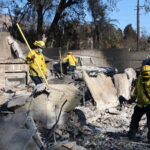Vermont’s total cost of recovering from Tropical Storm Irene is estimated at $733 million, and the federal government is expected to pay about three-quarters of that amount, Administration Secretary Jeb Spaulding said Thursday.
About $486 million is to repair roads, bridges and other infrastructure including the Waterbury state office complex, $117 million is to help people deal with the aftermath of last summer’s storm and the rest is to help businesses and communities manage the environmental impact of the storm and prepare for the next one.
Of the total Irene recovery costs, the estimate is the state will have to pay about $110 million, Spaulding said during a briefing in Montpelier, where he and other officials outlined the state’s progress is recovering from the Aug. 28 storm. Private funding and insurance will cover about $75 million.
Gov. Peter Shumlin said the state had much to celebrate.
“We have had many great successes. I think our recovery from Irene is a national model for how to recover from disaster,” Shumlin said to open the meeting. “That’s not to suggest we don’t have challenges ahead, and one thing we have said, for people who got hit so hard, lost their homes, lost their business, lost their belongs, lost everything materially that they cherished, this is a very tough and will be a long recovery.”
In the immediate aftermath of the storm, more than 500 miles of roadways and dozens of bridges were damaged or destroyed and thousands of people were forced from their homes. Now, the roads and bridges are open again, but about 800 residents are without long-term living arrangements.
Transportation Secretary Brian Searles said there were 672 road and bridge repair projects. Engineers are re-inspecting the repairs. Of the 435 that have been inspected, 213 will require further work.
Searles said he anticipated “those permanent repairs will take us through the next couple of years.”
Deputy Housing Commissioner Jennifer Hollar said 3,500 homes suffered some level of damage and about 1,400 households were displaced. The state is poised to receive $21.7 million in federal housing funds for unmet needs.
Some of the people who haven’t found permanent housing could be living with friends or relatives or in unsafe housing, officials said.
Hollar said a challenge of the grant from the Department of Housing and Urban Development is the requirement that 80 percent of the money be spent in hardest-hit Washington and Windsor counties. But she said other areas need access to more funds as well.
“We feel really strongly that every Vermonter with remaining needs should have equal access to those disaster … funds,” Hollar said.
As part of an effort to prepare for the next storm, the Federal Emergency Management Agency has agreed to buy out 91 primary homes, nine non-primary homes and six commercial properties in floodplains, paying 75 percent of their value. State and private groups are working to pay the property owners the remaining 25 percent. The buildings will be razed so they can’t be damaged by a future storm.
By the first week of June, FEMA had received 7,252 registrations from Irene and distributed $22.7 million in grants to families and individuals, including 220 households that received the maximum grant to $30,200. The Small Business Administration has approved $17.6 million in disaster loans for homeowners and renters.
Across the state, nine long-term recovery committees have been established working in the hardest-hit areas. Volunteers working with the committees have reached out to all Vermont residents who registered with FEMA.
“We’re constantly trying to see who needs help who may not have come forward yet,” state Chief Recovery Officer Sue Minter said. “People are still starting to come forward. That’s the story now: People who thought they could do it on their own are actually realizing they can’t.”
Was this article valuable?
Here are more articles you may enjoy.

 Catastrophe Experts Tap AI to Tackle Soaring Insured Losses
Catastrophe Experts Tap AI to Tackle Soaring Insured Losses  New Fire Maps Put Nearly 4M Californians in Hazardous Zones
New Fire Maps Put Nearly 4M Californians in Hazardous Zones  FAA Must Do Better After Midair Collision, Acting Chief Says
FAA Must Do Better After Midair Collision, Acting Chief Says  Trump’s Trade War Forces Canada into Decision on Whether to Hit US Autos
Trump’s Trade War Forces Canada into Decision on Whether to Hit US Autos 